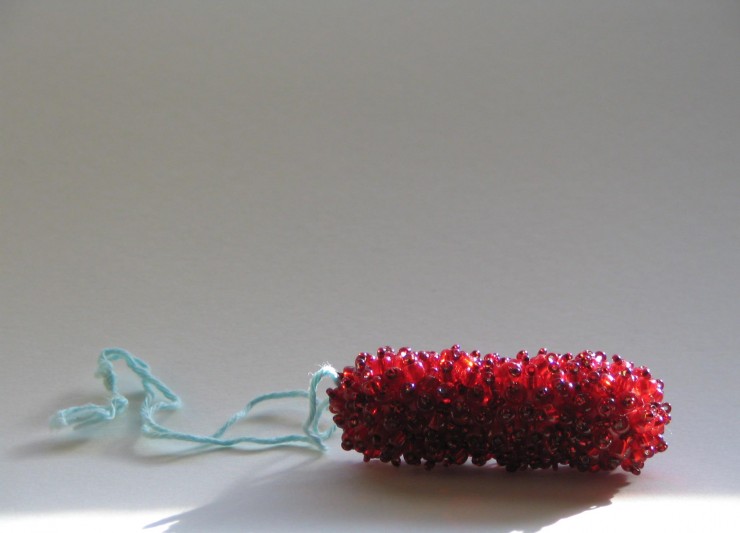Two concurrent sessions continue the menstrual exploration with imagination and practicality on Saturday, June 6th at at the 21st Biennial Conference of the Society for Menstrual Cycle Research at The Center for Women’s Health and Human Rights, June 4-6, 2015, Suffolk University, Boston.
Imagining Blood:
Menstrual Heterotopias in Spatial Art Practice
Ruth Green-Cole, NorthTec & Victoria University of Wellington
Menstruation is a significant marker of sexual difference; it is ‘gendered blood’ that divides and distinguishes women, and that has made them in many cases by association, the ‘subjects’ of taboo. The contemporary spatial artworks I present are instrumental in undermining this stigma and bring about changes in what we assume to be the function and value of art.
Image credit: Danielle Hogan
Special Edition Playtex, 2006
(from the Value Added series 2003-2006)
Collection of the Artist
Artist website: Danielle Carla Hogan
Blood For Thought: A closer look on contemporary conceptualization of menstruation
Anna Krol, Purchase College
What does it mean to menstruate in our culture? What is said (and not said) about bodies in relation to the conceptualization of periods in Western culture reveals deeper layers of sociopolitical fears and imperatives that involve challenges to traditional, authoritative, privileged-based reason prescribed to all for and by the privileged.
Mucus: The other taboo fluid
Lisa Leger, Justisse Healthworks for Women
While making menstruation matter at #SMCR2013, Lisa Leger asked “Where’s the Blood?” in pop culture’s sexy vampire stories. At this year’s conference, she explores “Where’s the Mucus?” in any form of entertainment or even sex ed. We rarely see references to menstrual blood in stories about women. Cervical mucus is mentioned even less. Our culture’s squeamishness causes an unfair knowledge gap. Let’s decode the mysteries of the mucus. Reproductive justice includes awareness, understanding and acceptance of cervical mucus as a normal, healthy part of female reproductive health.
Social Context and Identity:
 You Menstrual Me
You Menstrual Me
Emily Graves, Louisiana State University
In a series of 26 very short, original poems written in the second person, I represent discourses of menstruation through aesthetic performance. Calling on the corporeal body to translate poetic expression from the page to the stage, the performance pursues the meeting of embodied language and language about bodies.
Between weirdness & empowerment: How social class shapes girls’ experiences of menarche and the female body
Theresa E. Jackson, Northeastern University
This qualitative study investigates how girls from diverse social locations make meaning out menarche and their changing bodies. Results indicate that all girls appropriate messages of shame related to menstruation. Discussions of the female body diverged according to social class where working-class participants highlighted vulnerability and middle-class participants acknowledged empowerment.
The optimal choice for menstrual protection for women: Reflections of MHM campaigners of MITU, an NGO, based on their experiences of three years in Rural Karnataka India
Kala Charlu, Multiple Initiatives Towards Upliftment
This paper presents findings from a Bangalore based organisation, MITU (Multiple Initiatives Towards Upliftment) on what are the right alternatives for protection during menstruation based on the last three years’ work with over 5000 under-privileged girls and women in Bangalore and Rural Karnataka. Conflicting objectives like health, hygiene, convenience, affordability and Eco-friendliness have made us ponder over the right way forward in this continuously evolving scenario.
Looking back, looking ahead: Two NGOs in India collaborate in a sanitary napkin user trial and critically examine their field interventions
Lakshmi Murthy, Industrial Design Centre, Indian Institute of Technology & Kala Charlu, Multiple Initiatives Towards Upliftment
Collaborative reflective studies in the area of menstruation were conducted by two NGOs in culturally diverse rural locations in India. In Study 1, 50 users compared two menstrual products. In Study 2, we interviewed 60 users to assess effectiveness of NGO interventions. Results helped both NGOs to redesign future goals.
Media Release and Registration for the SMCR Boston Conference on Menstrual Health and Reproductive Justice: Human Rights Across the Lifespan.


